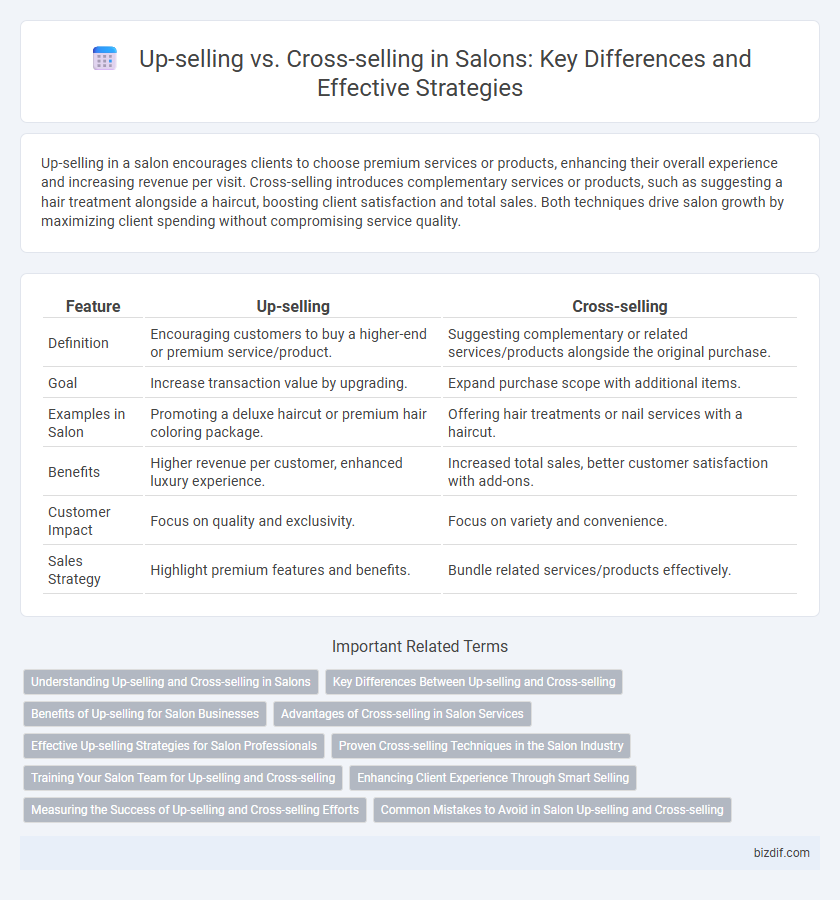Up-selling in a salon encourages clients to choose premium services or products, enhancing their overall experience and increasing revenue per visit. Cross-selling introduces complementary services or products, such as suggesting a hair treatment alongside a haircut, boosting client satisfaction and total sales. Both techniques drive salon growth by maximizing client spending without compromising service quality.
Table of Comparison
| Feature | Up-selling | Cross-selling |
|---|---|---|
| Definition | Encouraging customers to buy a higher-end or premium service/product. | Suggesting complementary or related services/products alongside the original purchase. |
| Goal | Increase transaction value by upgrading. | Expand purchase scope with additional items. |
| Examples in Salon | Promoting a deluxe haircut or premium hair coloring package. | Offering hair treatments or nail services with a haircut. |
| Benefits | Higher revenue per customer, enhanced luxury experience. | Increased total sales, better customer satisfaction with add-ons. |
| Customer Impact | Focus on quality and exclusivity. | Focus on variety and convenience. |
| Sales Strategy | Highlight premium features and benefits. | Bundle related services/products effectively. |
Understanding Up-selling and Cross-selling in Salons
Up-selling in salons involves encouraging clients to purchase a more premium service or product than initially intended, such as upgrading a basic haircut to include a deep conditioning treatment. Cross-selling focuses on recommending complementary services or products, like suggesting a manicure alongside a pedicure or retail haircare items after a styling session. Both strategies enhance customer experience and boost salon revenue by tailoring offers to clients' specific needs and preferences.
Key Differences Between Up-selling and Cross-selling
Up-selling in a salon involves encouraging clients to purchase a more premium service or treatment, such as upgrading a basic haircut to a deluxe package with conditioning or scalp massage. Cross-selling focuses on recommending complementary products or services, like suggesting hair care products or a manicure alongside a haircut appointment. Both strategies aim to increase revenue but differ in approach: up-selling enhances the current service with higher-value options, whereas cross-selling introduces additional, related offerings.
Benefits of Up-selling for Salon Businesses
Up-selling in salon businesses increases average transaction value by encouraging clients to choose premium services or add-ons like hair treatments or extended styling sessions. This strategy enhances customer satisfaction through personalized experiences while boosting salon revenue and client retention. Effective up-selling leverages skilled consultation to highlight benefits of upgraded options, creating long-term loyalty and higher profitability.
Advantages of Cross-selling in Salon Services
Cross-selling in salon services increases revenue by encouraging clients to try complementary treatments such as hair conditioning with a haircut or manicures alongside pedicures. It enhances the customer experience by offering personalized service packages tailored to individual preferences and beauty goals. This strategy builds customer loyalty and satisfaction by promoting a holistic approach to self-care, leading to higher retention rates.
Effective Up-selling Strategies for Salon Professionals
Effective up-selling strategies for salon professionals include personalized service recommendations based on clients' hair type, style preferences, and previous treatments, enhancing client satisfaction and increasing revenue. Offering premium product upgrades, such as luxury shampoos or deep conditioning treatments, encourages clients to invest in higher-quality options tailored to their needs. Training staff to confidently suggest complementary enhancements during consultations maximizes client value without compromising the service experience.
Proven Cross-selling Techniques in the Salon Industry
Proven cross-selling techniques in the salon industry include recommending complementary services such as hair treatments alongside haircuts and suggesting product bundles tailored to individual hair types. Upselling often focuses on premium services, but cross-selling enhances customer satisfaction by offering add-ons like scalp massages or styling products that address specific client needs. Utilizing client appointment history and preferences enables salon professionals to personalize cross-sell offers effectively, increasing both client retention and average transaction value.
Training Your Salon Team for Up-selling and Cross-selling
Training your salon team to master up-selling and cross-selling techniques directly boosts revenue by encouraging clients to purchase higher-end services or complementary products. Effective training programs should include role-playing scenarios, product knowledge sessions, and personalized communication strategies to build confidence and enhance customer experience. Empowered staff can seamlessly identify opportunities to recommend treatments or retail items that meet client needs, driving both satisfaction and sales growth.
Enhancing Client Experience Through Smart Selling
Up-selling in salons involves recommending premium services like advanced hair treatments or luxury spa packages to elevate the client's experience and satisfaction. Cross-selling promotes complementary products such as hair care items, styling tools, or skincare essentials that align with the client's current services, boosting both value and convenience. Implementing smart selling strategies tailored to individual client needs enhances overall engagement and drives revenue growth while fostering long-term loyalty.
Measuring the Success of Up-selling and Cross-selling Efforts
Measuring the success of up-selling and cross-selling in a salon involves tracking key performance indicators such as increased average transaction value, customer retention rates, and the frequency of add-on service purchases. Utilizing point-of-sale data and customer feedback helps identify which products or services generate the highest incremental revenue. Analyzing these metrics enables salon managers to refine sales strategies and enhance overall profitability.
Common Mistakes to Avoid in Salon Up-selling and Cross-selling
Common mistakes to avoid in salon up-selling and cross-selling include pushing products or services that do not align with the client's needs or preferences, which can lead to dissatisfaction and loss of trust. Failing to train staff on personalized consultation techniques often results in generic recommendations that feel insincere or forced. Overloading clients with too many suggestions in one visit can overwhelm them and reduce the likelihood of successful conversions.
Up-selling vs Cross-selling Infographic

 bizdif.com
bizdif.com